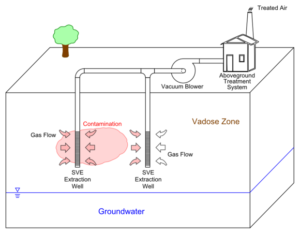Construction Term of the Month: Vapor Intrusion
The Environmental Protection Agency (EPA) defines vapor intrusion as “the general term given to migration of hazardous vapors from any subsurface contaminant source, such as contaminated soil or groundwater or contaminated conduit(s), into an overlying building or unoccupied structure via any opening or conduit.” In other word, volatile chemicals that are released earth as liquids or solids form hazardous vapors that eventually enter a building as a component in gas.
These volatile chemicals can range from volatile organic compounds (VOCs), semi-volatile organic compounds, and inorganic chemicals such as elemental mercury, naturally-occurring radon, and hydrogen sulfide. Vapor intrusion can be caused by on-site or off-site contamination as it is possible for contaminates to migrate from a neighboring property above or below ground. Dry cleaning solvents and petroleum products are common examples of contaminants which can cause vapor intrusion.
 Vapor intrusion can pose a substantial risk to human by exposure to toxic chemicals and, in the case of methane gas, imminent danger of explosion. An important part of due diligence for building or land purchase is an environmental assessment for the risk for Vapor Intrusion and Vapor Encroachment.
Vapor intrusion can pose a substantial risk to human by exposure to toxic chemicals and, in the case of methane gas, imminent danger of explosion. An important part of due diligence for building or land purchase is an environmental assessment for the risk for Vapor Intrusion and Vapor Encroachment.
Resources:
- EPA Consumer information about Vapor Intrusion
- EPA’s OSWER Technical Guide for Assessing and Mitigating the Vapor Intrusion Pathway from Subsurface Vapor Sources to Indoor Air


0